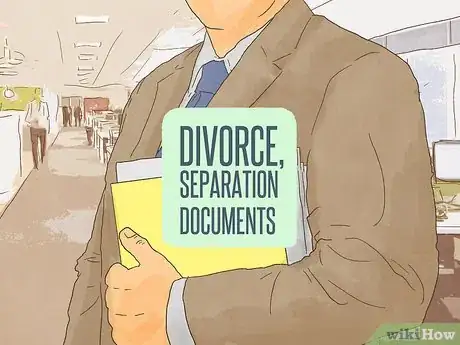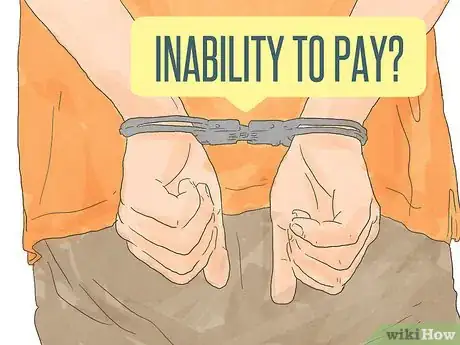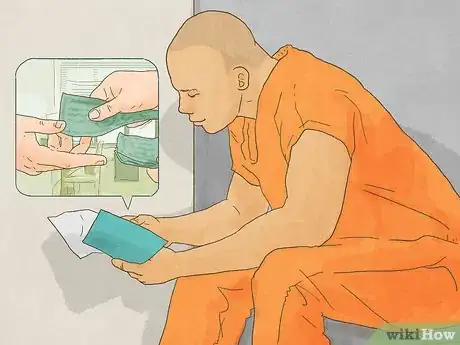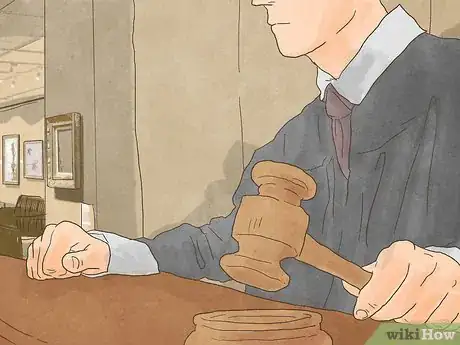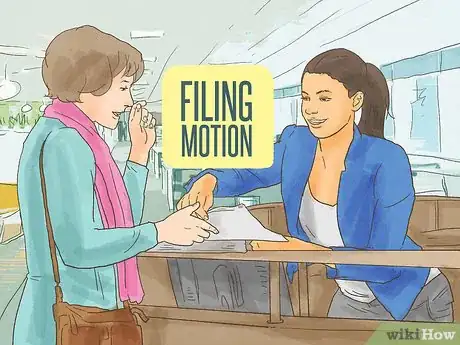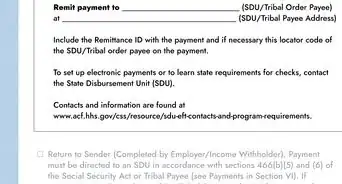This article was co-authored by Clinton M. Sandvick, JD, PhD. Clinton M. Sandvick worked as a civil litigator in California for over 7 years. He received his JD from the University of Wisconsin-Madison in 1998 and his PhD in American History from the University of Oregon in 2013.
There are 9 references cited in this article, which can be found at the bottom of the page.
This article has been viewed 57,653 times.
Child support obligations generally do not end simply because a parent is imprisoned. Instead, they continue until modified by a court. If a parent is in prison and you haven’t yet received an initial child support order, then contact your state’s Attorney General’s Office. You need to get an initial child support order in place. However, if you already have an order when the parent is incarcerated, then one of two things will happen. The parent will either file a motion to modify the child support, or the parent will stop making payments and ignore you. If the parent stops paying, then you should file a contempt motion with the court if you think the parent can afford to pay.
Steps
Establishing an Initial Child Support Order
-
1Contact your state’s Attorney General’s Office. Every state has established child support enforcement agencies that help parents collect child support. In many states, the Attorney General’s Office helps parents.[1] Other states have created local agencies to perform the same role. A child support enforcement agency can help you get an initial child support order.
- To find your office, search “child support enforcement” and “your state.”
- If you currently receive Temporary Assistance for Needy Families (TANF) or Medicaid, then you should already be enrolled. The state office should contact you.[2]
-
2Complete an application. Once you contact the appropriate child support enforcement agency, you will be given forms to complete. Make sure to print legibly and return the forms as soon as possible. Although each state’s form is slightly different, you will generally be asked for the following information:[3]
- your name
- your address, telephone number, and email
- your Social Security Number
- your date of birth
- the other parent’s name, contact information, date of birth, and Social Security Number
- a physical description of the other parent
- the name, date and place of birth, race, sex, and Social Security Number for each child you are seeking child support for
- whether you are married to or divorced from the other parent
- who has legal custody of the children
- whether paternity has been established
- the other parent’s work history
Advertisement -
3Gather necessary supporting documentation. You may have to submit certain supporting documents along with your application. For example, in Texas, you will need any of the following that apply to your situation:[4]
- your divorce decree or separation agreement
- an acknowledgement of paternity (if one has been signed)
- birth certificates of all children involved
- evidence of any history of paying child support
- documents reflecting each parent’s income and assets, such as tax returns, bank statements, and paycheck stubs
-
4Establish paternity. The child support enforcement agency can also help you establish paternity. If you aren’t entirely sure who the father is, you can still apply for services. The agency will help establish paternity through the courts.
- The man might admit that he is the father. However, if he disagrees, then the court can order that DNA testing be done.[5]
-
5Attend a hearing to establish an initial child support order. Only a judge can establish an initial child support order, and the judge will want to hear from both sides. You might need to attend the hearing.[6] For example, you may need to attend in order to testify. However, the child support enforcement agency should do most of the work at the hearing.
- You should talk with the child support enforcement agency to ask how you can prepare for the hearing and what your role will be.
Opposing a Request to Modify Child Support
-
1Receive notification that a motion has been filed. When a parent is jailed, the child support order generally continues in effect. In some states, such as California, it may temporarily be suspended for 90 days unless the parent can pay.[7]
- Generally, however, only a judge can change the child support order. An incarcerated parent who wants to reduce or suspend child support payments can usually file a motion with the court asking that their child support be modified.
- The jailed parent might complete a form and send it to your state’s child support enforcement agency. The agency will review the information and decide whether to agree to the modification or to oppose it.
- If the parent files a motion to have their support payments modified, you should receive a copy.
-
2Read the motion to see what the other parent is claiming. Typically, the other parent will claim they are not able to pay child support because they are in jail and therefore unable to work. The parent will also ask the court to reduce the payments or temporarily suspend them.
- You should honestly assess whether you think the parent can continue to make child support payments even while in jail. Talk this over with your case worker.
- You should tell your case worker about any assets you think the parent has which could be used to pay for child support while they are in prison.
-
3Identify the incarcerated parent’s assets. Even though a parent may be in jail, he or she can still have assets which could be used to pay for child support. Think about whether the parent has any of the following:[8]
- income from rental properties
- disability, retirement, or other benefits
- interest or dividends earned from stocks, bonds, or other investments
- money from selling investments
- bank accounts, retirement accounts, or other accounts
- proceeds from selling property
-
4Think about meeting with a lawyer. Your state’s child support enforcement agency might oppose the other parent’s attempt to modify child support. In this situation, the agency will file documents in court and attend a hearing. However, the agency might decide not to oppose the incarcerated parent’s motion. (Remember, the agency represents the state, not you.) If you disagree with the child support enforcement agency’s decision, then you should seek out an attorney to consult.
- Only a qualified lawyer will be able to advise you whether you are likely to succeed in opposing the parent’s motion to modify. Make sure to show the lawyer proof that the jailed parent has assets that could be used to pay the child support.
- You can get a referral for a lawyer by contacting your state or local bar association. Call the lawyer and schedule a consultation.
-
5Respond to the other parent’s motion. To oppose the motion to modify, you need to file a response. Your court should have printed, “fill in the blank” forms for you to complete.[9] Ask the court clerk.
- On the response, you should be sure to identify the reasons why you think the incarcerated parent can continue to pay child support.
- There may be other forms you have to fill out, such as a sheet on which you report your income. The court clerk should give you the forms.
-
6File your response. Make several copies of your completed forms. Take the original and your copies to the court clerk and ask to file the original.[10] The clerk should stamp your copies with the filing date.
- You may have to pay a filing fee. If you can’t afford the fee, then ask for a fee waiver form.
-
7Serve notice. You must give the other parent and the child support enforcement agency notice that you are opposing the motion to modify child support. Ask the court clerk for acceptable methods of service of process.
- Whoever makes service will need to complete a “proof of service” or “affidavit of service” form.[11]
-
8Attend a hearing. Show up with copies of all documents filed.[12] Also have ready any documentation showing that the incarcerated parent has assets which could be used to pay child support. As the person opposing the motion, you will speak second.
- Listen quietly as the other parent makes his or her argument for modifying child support.
- When it is your turn to speak, explain why you think the other parent has sufficient assets to continue to pay child support while in prison. Ask the judge if he or she wants to see your documentation.
-
9Receive the decision. The judge has a couple of options. For example, the judge can deny the jailed parent’s motion and leave the child support payments as is. Alternately, the judge can reduce or suspend the child support payments. If you win at the hearing, you may have to draft a copy of the order. Ask the court clerk if there is a blank order form.
- In some courts, the clerk will fill out the order. Be sure to get a copy and read it closely. It will tell you what changes (if any) have been made to the parent’s child support payments. If the changes are temporary, note the date when the order expires.
- If you didn’t receive a copy of the order, contact the court clerk.
Filing a Contempt Action for Nonpayment
-
1Contact your state’s child support enforcement agency. The other parent might not try to modify the child support order. Instead, he or she might simply ignore child support obligations while in prison. When a parent does not pay child support, they are “in arrears.” You should contact your case worker at the child support enforcement agency.
- Your next steps will depend on your state’s law. In some states, the parent won’t have to make payment if incarcerated; however, support obligations will start up again when the parent is released from jail.
- In other states, you might be able to file a contempt motion while the parent is in prison, especially if you have identified assets the parent could use to pay child support while incarcerated.[13]
-
2File a motion for contempt. A person is in “contempt” when they ignore a court order. You can file a motion for contempt with the court that entered your child support order. In response, the incarcerated parent will have to prove he or she can’t afford to pay.[14]
- You should let your child support enforcement agency handle filing the motion of contempt.
- Be sure to get a copy of the motion.
-
3Read the other parent’s response. The incarcerated parent has a chance to oppose your contempt motion. In the response, the incarcerated parent should explain to the court why he or she can’t make support payments.[15]
- You should receive a copy of the other parent’s response. If not, ask your case worker for a copy.
-
4Attend a hearing. At the hearing, the jailed parent has the burden of convincing the judge that he or she can’t afford to make payments while in prison. The child support enforcement agency should send a representative to the hearing to argue why the parent should pay.
- You might have to answer questions posed by the judge. Talk ahead of time with your case worker about what your role will be at the hearing.
-
5Receive payment. Ideally, the contempt motion will prompt the parent to pay child support if he or she has assets. The payments should be made to your state agency, which will disburse them to you.
- Unfortunately, you can’t get water from a stone. If the other parent doesn’t pay while in prison, there is little the court can do. The typical punishment for contempt is imprisonment, but the other parent is already in prison.[16] For this reason, contempt might not jog the other parent to pay while they are in jail.
- However, child support obligations will continue to accumulate, and interest on the payments will also accrue as the parent serves out his or her jail sentence. When the parent is released, you can garnish his or her wages and intercept tax returns to get your owed child support.
References
- ↑ https://www.texasattorneygeneral.gov/cs/welcome-to-the-child-support-division
- ↑ https://www.texasattorneygeneral.gov/faq/cs-parents-frequently-asked-questions
- ↑ https://dss.mo.gov/child-support/pdf/csebundle.pdf
- ↑ https://www.texasattorneygeneral.gov/faq/cs-parents-frequently-asked-questions
- ↑ http://www.state.sc.us/dss/csed/faqs.htm
- ↑ http://www.state.sc.us/dss/csed/faqs.htm
- ↑ http://www.courts.ca.gov/1200.htm
- ↑ http://www.masslegalhelp.org/children-and-families/child-support/in-jail
- ↑ http://www.courts.ca.gov/documents/fl393.pdf
- ↑ http://www.courts.ca.gov/documents/fl393.pdf
- ↑ http://www.courts.ca.gov/documents/fl393.pdf
- ↑ http://www.courts.ca.gov/documents/fl393.pdf
- ↑ http://www.masslegalhelp.org/children-and-families/child-support/in-jail
- ↑ http://www.masslegalhelp.org/children-and-families/child-support/in-jail
- ↑ http://www.masslegalhelp.org/children-and-families/child-support/in-jail
- ↑ http://www.state.sc.us/dss/csed/faqs.htm


